 (Image: HTX/Law Yong Wei)
(Image: HTX/Law Yong Wei)
What has HTX been up to in the engineering space, and what waves are we about to create?
Visitors to the latest TechXplore showcase, held on 14 October 2025 at Garage@HTX – Singapore’s first purpose-built engineering Developmental Testing and Evaluation (DT&E) facility – got a glimpse into the answer.
More than 500 Xponents and Home Team colleagues gathered to explore over 20 cutting-edge engineering solutions, including drones, robots and diagnostic tools for forensics – technology you’d expect to see in a sci-fi movie, but made real by HTX.
Here’s a look at some of the solutions presented at TechXplore:
Addressing hostile drones
It’s no secret that modern drones can be a double-edged sword. They’re capable of making life easier – think logistics deliveries – but can also be a serious threat when they are weaponised.
In Singapore, our dense, high-rise urban environment presents unique technical challenges in the defence against hostile drones.
As our radio frequency (RF) spectrum is already congested with Wi-Fi, cellular and Bluetooth signals, trying to sift through all that noise just to locate signals from one hostile drone – and hence determine its position – is no easy feat.
Add to that the complexity of our city landscape, which is filled with many tall buildings that can cause line-of-sight blockages and obstruct the path of a counter-drone sensor. In fact, buildings can even create unwanted multipath effects as signals end up bouncing off their surfaces.
Does HTX have a solution? Yes, and it’s a layered one.
It begins with the Rapid Deployable Counter-Unmanned Aerial System (C-UAS) System (RDS), an in-house architected, unified autonomous platform that delivers advanced detection and interdiction of drones through an integrated suite of sensors and countermeasures.
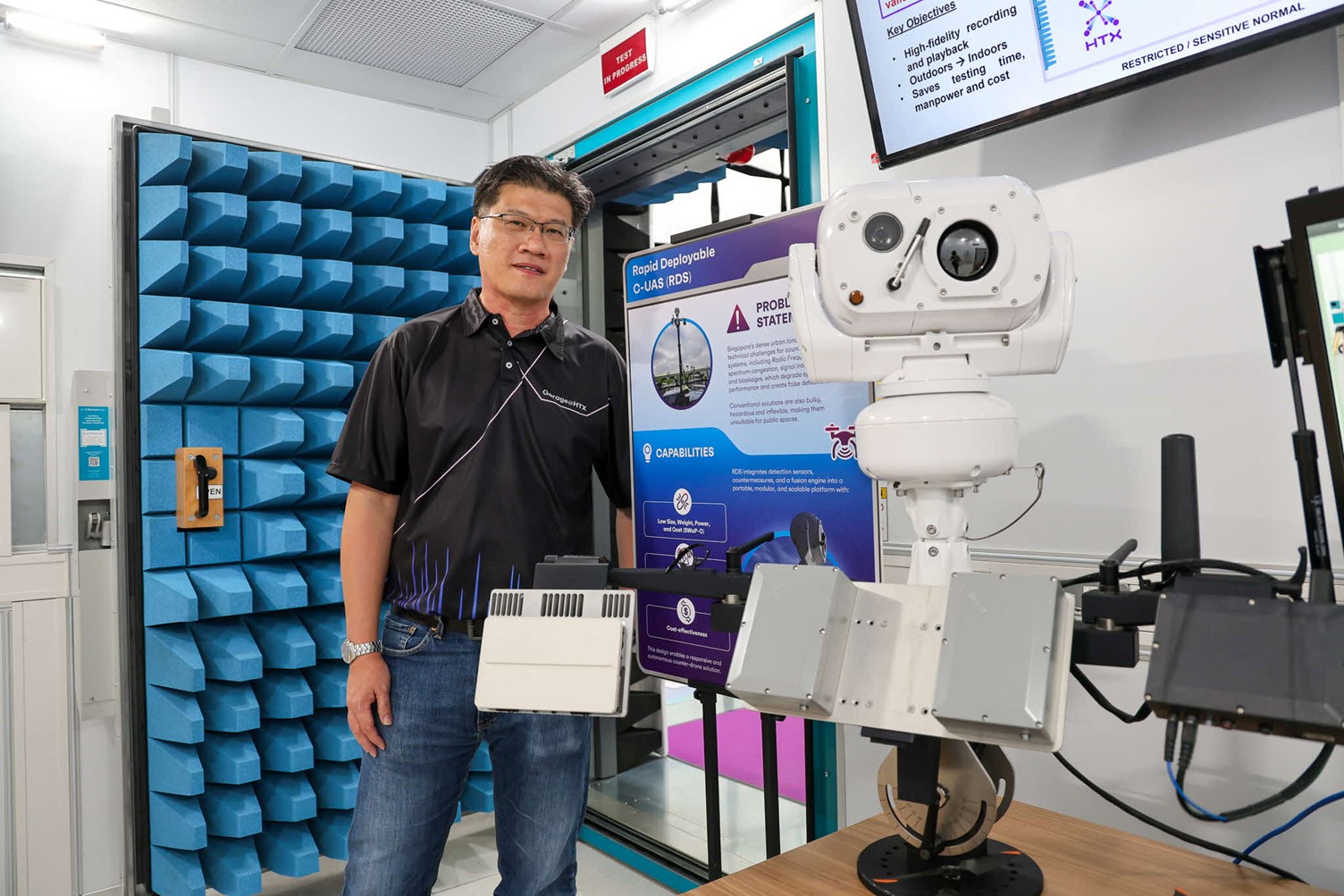 HTX Senior Principal Engineer Dr Ben Soon presents the RDS at TechXplore. (Photo: HTX/Law Yong Wei)
HTX Senior Principal Engineer Dr Ben Soon presents the RDS at TechXplore. (Photo: HTX/Law Yong Wei)
The RDS can locate a hostile drone using computer vision powered by artificial intelligence (AI) driven and block its communication links and Global Positioning System (GPS) signals, thus ceasing its functions.
The RDS is also fitted with an advanced Command and Control (C2) fusion engine that combines inputs from multiple sensors, which even reduces false alarms and operator fatigue.
According to Dr Ben Soon, Senior Principal Engineer, Solutions & Architecture, 3i, Robotics, Automation and Unmanned Systems Centre of Expertise (RAUS CoE), the RDS stands out from conventional counter-drone solutions because it is portable, modular and scalable, and is lighter, smaller and less costly.
What’s more, it can be set up in 30-90 minutes and scaled up in a plug-and-play approach to provide comprehensive coverage of a specific area.
In contrast, conventional solutions tend to be bulky, obtrusive and risky to personnel since they rely on high-power radars and jammers that emit radiation.
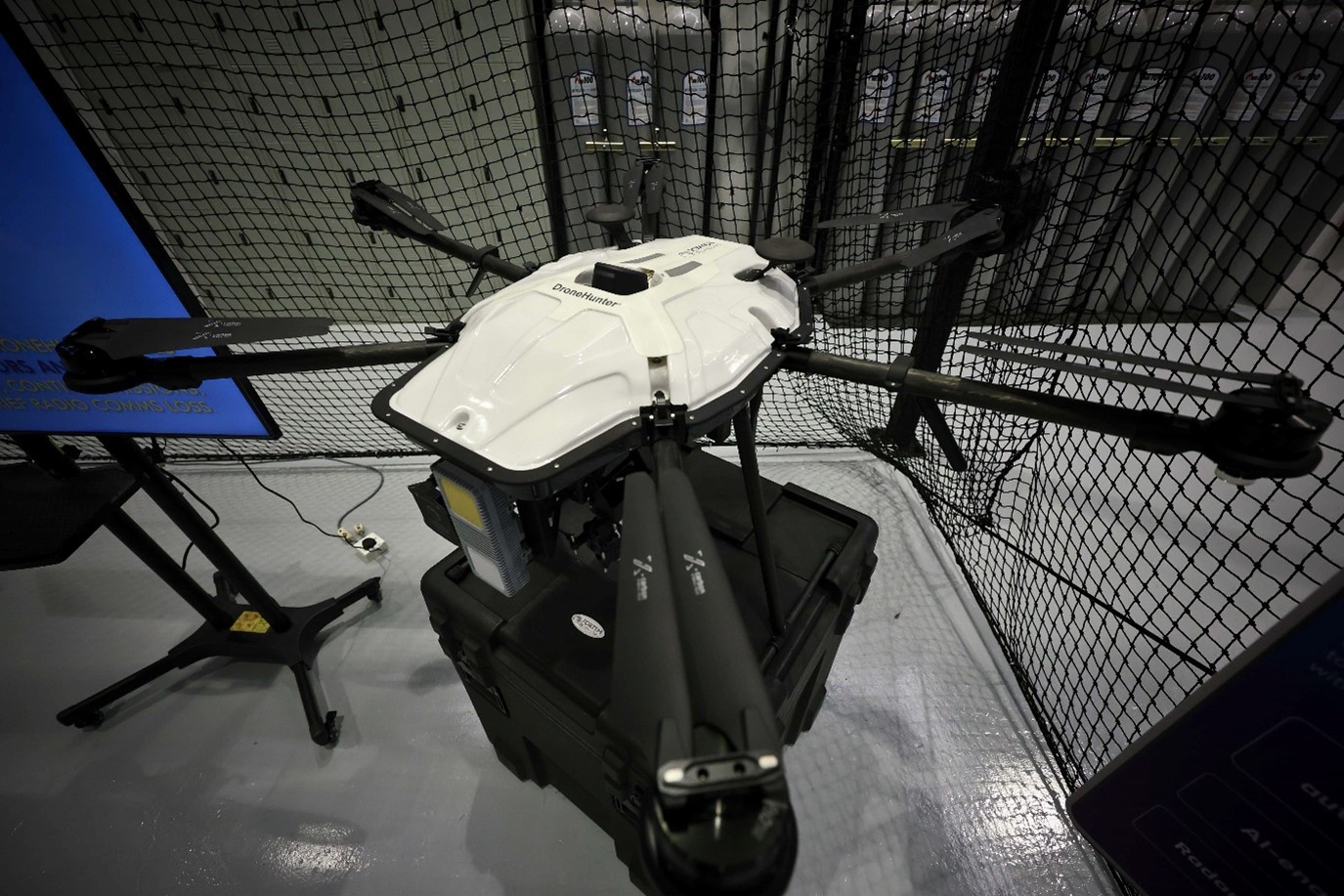 Meet HTX’s hi-tech “drone hunter”. (Photo: HTX/Alywin Chew)
Meet HTX’s hi-tech “drone hunter”. (Photo: HTX/Alywin Chew)
But jamming a hostile drone is just one part of the equation. After all, a jammed drone will still hover in place until its battery runs out, following which it would just come crashing down. This is problematic, especially if the drone is carrying a dangerous payload.
And that’s where the next layer of defence comes into play: a drone interceptor.
Designed in partnership with Fortem Technologies, this “drone hunter” can speedily pursue and capture a hostile drone with nets before transporting it to a secure zone for safe disposal.
The drone interceptor is the first of its kind in the world to operate independently of GPS, and this is critical because conventional drones can’t operate in an environment where signals have already been jammed.
Extending a helping hand
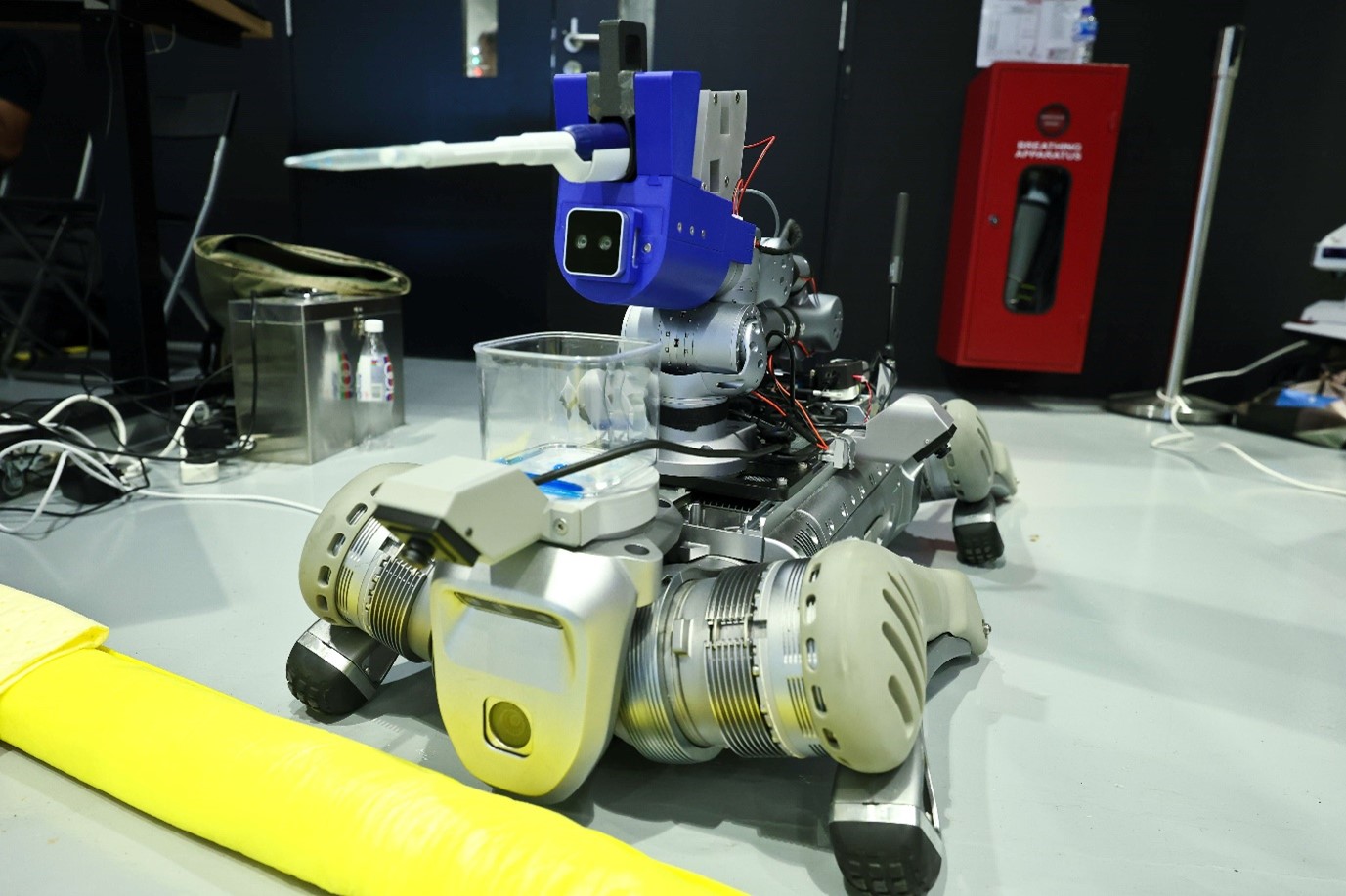 HTX’s haptic-enabled mobile manipulator attached to a robot dog. (Photo: HTX/Alywin Chew)
HTX’s haptic-enabled mobile manipulator attached to a robot dog. (Photo: HTX/Alywin Chew)
Futuristic as it looks, the haptic-enabled mobile manipulator doesn’t belong to Iron Man’s technology labs. It was, in fact, developed by engineers from HTX’s RAUS CoE.
A robotic arm that can be attached to different hardware, such as a robotic dog, this manipulator has end-effectors that can also be easily switched – from pipette systems for liquid sampling (seen above) to gas detection equipment for atmospheric monitoring, and a robotic hand for precise object handling.
Most importantly, it can be remotely operated via tele-presence, meaning Home Team officers can undertake tasks in hazardous environments from afar.
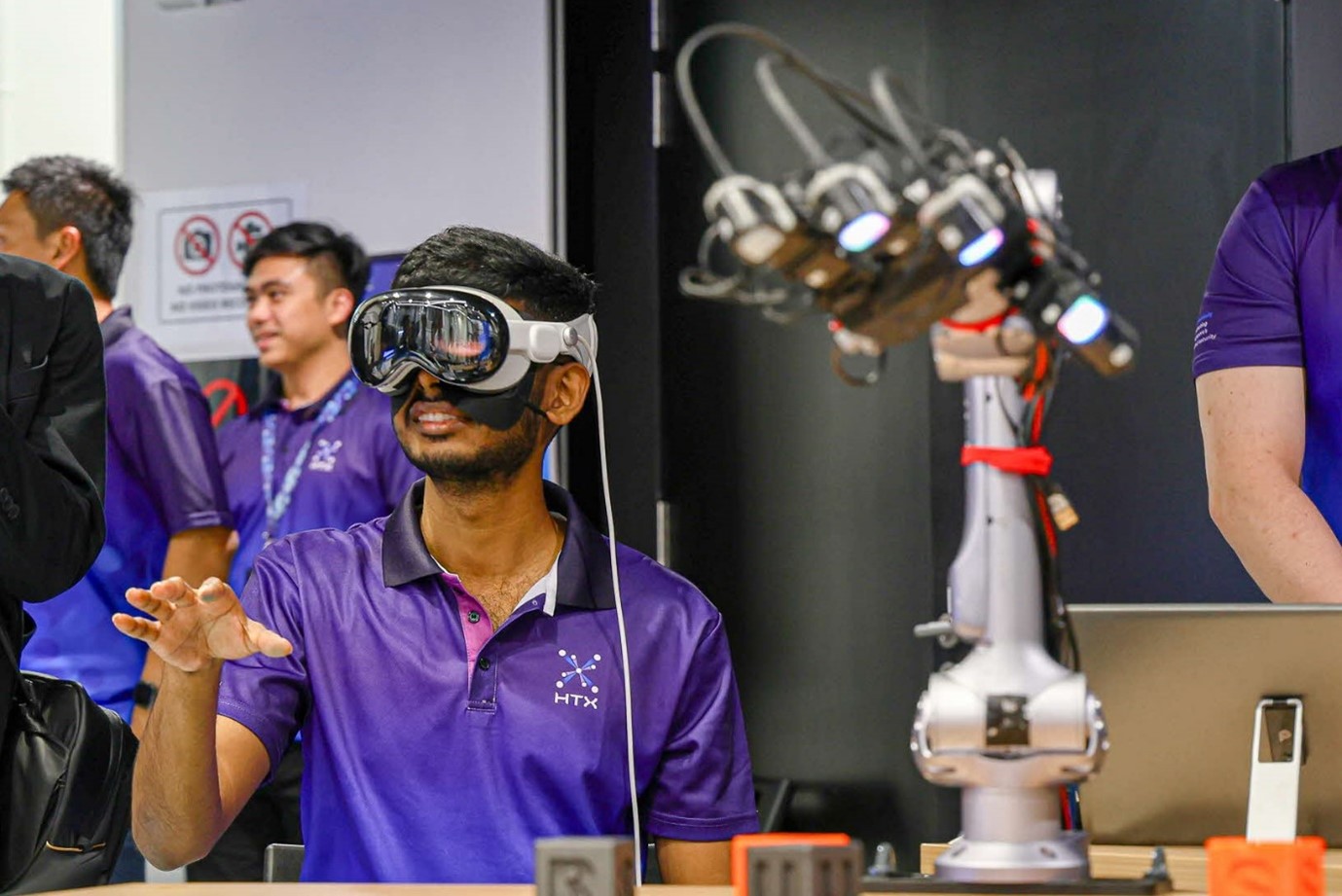 HTX engineer Ganeshan Sureendhar demonstrates the use of the VR headset in controlling the robotic hand’s movements. (Photo: HTX/Law Yong Wei)
HTX engineer Ganeshan Sureendhar demonstrates the use of the VR headset in controlling the robotic hand’s movements. (Photo: HTX/Law Yong Wei)
“The robot’s virtual reality (VR) headset can also track individual finger movements, which will translate to intuitive control of the robotic hand,” explained Timothy Lim, Engineer, Tech Stack, 3i, RAUS CoE.
“For example, it could spread its fingers laterally to achieve a wider grip on odd-shaped objects, such as glass vials.”
Capable of haptic feedback, the robotic hand allows for material interaction sensing – meaning the user would have a sense of touch when controlling the hand. This is important as it helps enhance their situational awareness and make tele-operation feel more realistic, ultimately resulting in better control.
Seeing underwater
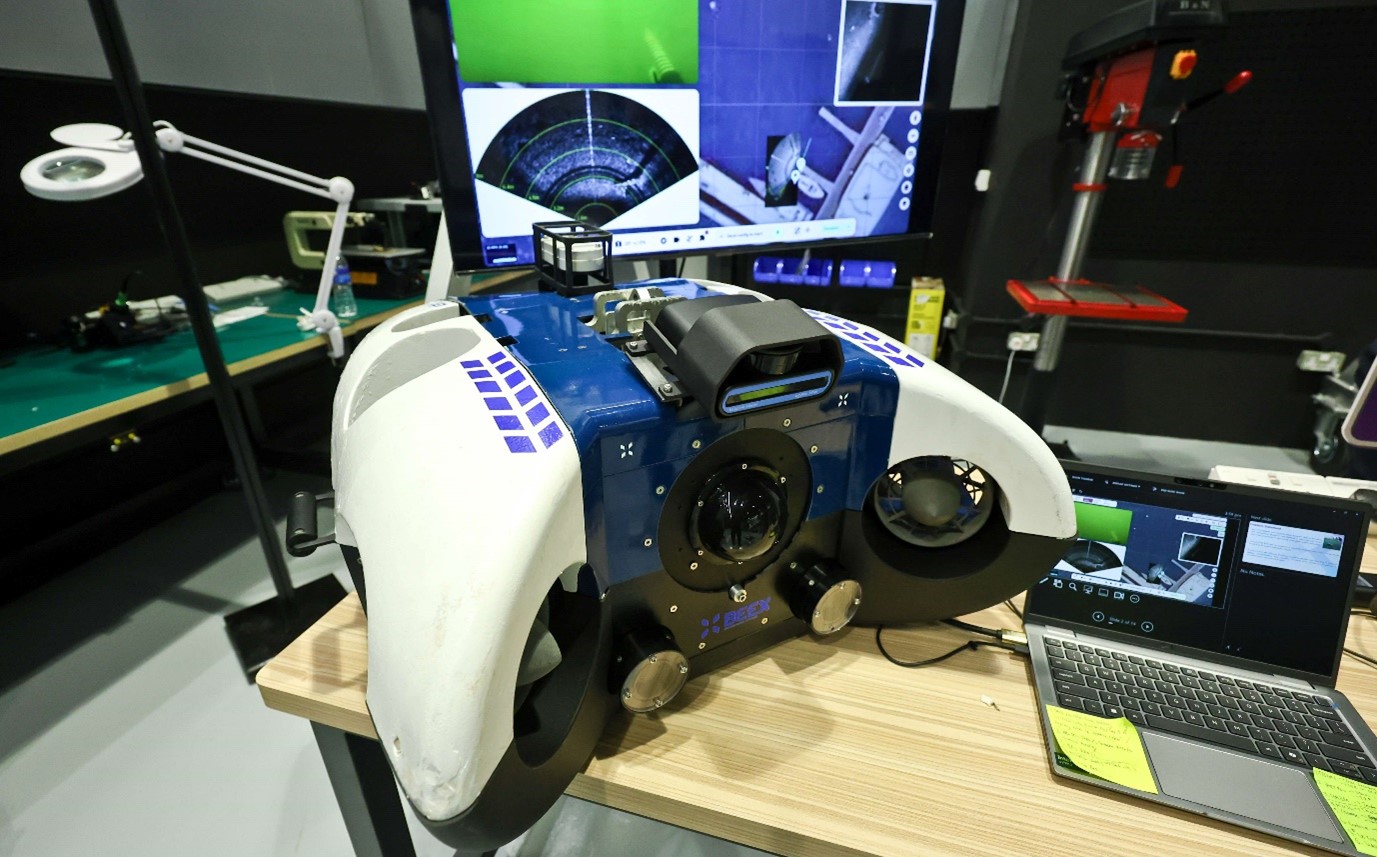 HTX’s AI-enabled Remotely Operated Vehicle (ROV) for autonomous underwater search operations. (Photo: HTX/Alywin Chew)
HTX’s AI-enabled Remotely Operated Vehicle (ROV) for autonomous underwater search operations. (Photo: HTX/Alywin Chew)
Searching for people or objects in the waters off Singapore can be a tall task because visibility under the surface is notoriously low.
While deploying Remotely Operated Vehicles (ROVs) can help the Home Team in such challenging underwater operations, operators still need to manually scrutinise sonar and camera feeds in real time to spot their targets – a laborious process that’s prone to human error.
HTX’s RAUS CoE has leveraged AI to tackle this issue.
“Our AI-enabled ROV can autonomously detect potential underwater targets, move in to perform a high-resolution scan, and relay its position so that divers can be directed precisely to the spot for recovery,” shared Jerryl Neo, Engineer, Maritime Systems, RAUS CoE.
“These developed capabilities overcome the key limitations of today’s commercial off-the-shelf ROVs, potentially enabling more effective and optimised underwater search operations for the Home Team.”
Enhancing vehicles
Upgrading smart devices on existing vehicles, like cameras or sensors, can be time-consuming. It involves extensive processes such as rewiring, retrofitting and cybersecurity revalidation – sometimes even requiring an overhaul of the entire vehicle.
But with the Common Vetronics Architecture (CVA), this long process could be a thing of the past.
Conceptualised by HTX’s Vehicle and Weapon (VWS) CoE, the CVA’s standardised vehicle electronics design will enable plug-and-play capabilities, facilitating faster developmental cycles and quicker upgrades.
“We have designed the CVA to be applied across the Home Team’s vehicles, regardless of size or number of smart devices required,” shared Chan Ka Keong, Lead Engineer, Smart Vehicle Systems Integration, VWS CoE.
The CoE is also looking into improving the transport of food and goods within Singapore’s prison compounds with its Autonomous Remote Movers (ARM) project, an integrated solution featuring autonomous vehicles (AVs) and mobile robots (MRs).
How does this work? Well, autonomous trucks will transport food or goods from one location to another before MRs autonomously pick up the packages and deliver them within buildings.
A customised fleet management system that will facilitate communication between the AVs and MRs and coordinate their movements is also being designed.
“We’ve been working closely with the Singapore Prison Service (SPS) to identify their operational problems, conduct market research and propose potential solutions such as ARM,” said Lim Ken Zho, Engineer, Autonomous Vehicle Solutions, VWS CoE.
“On top of enhancing overall operational effectiveness, ARM would also help to augment existing manpower.”
Currently a proof-of-concept, a trial will be conducted with the SPS in September 2026.
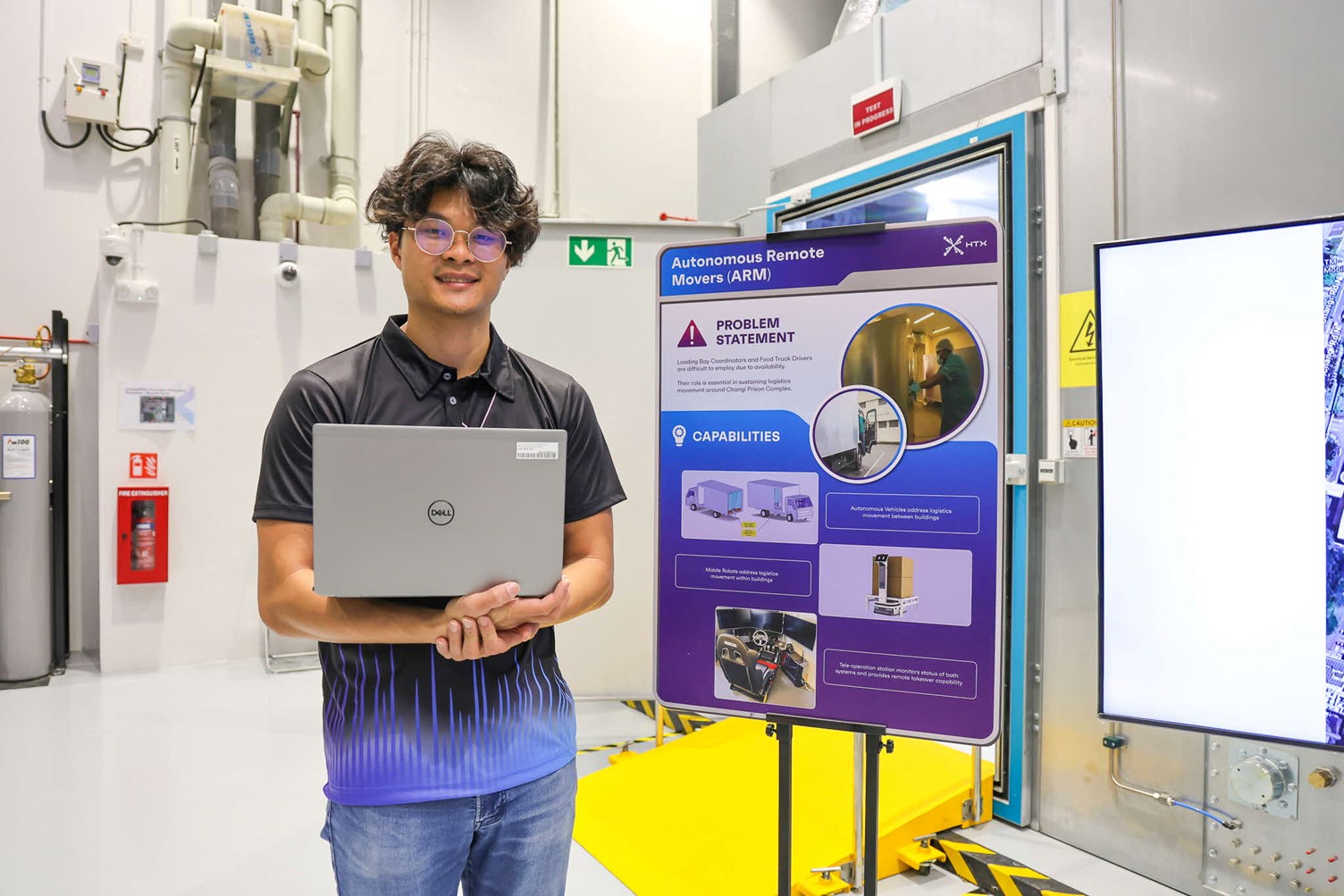 Engineer Lim Ken Zho presents the ARM project at TechXplore. (Photo: HTX/Law Yong Wei)
Engineer Lim Ken Zho presents the ARM project at TechXplore. (Photo: HTX/Law Yong Wei)
Visitors to TechXplore were impressed with the showcased technologies and their potential to strengthen the Home Team’s operations.
One of them was Operations Officer Louis Loh from the Singapore Police Force’s (SPF) Operations Department.
“The exhibits on the unmanned systems in the aerial and maritime domains particularly stood out to me. I think that the capabilities in these domains to deploy and guard against [threats] are especially relevant in today’s geopolitical context, and in supporting the SPF’s operations,” he said.

